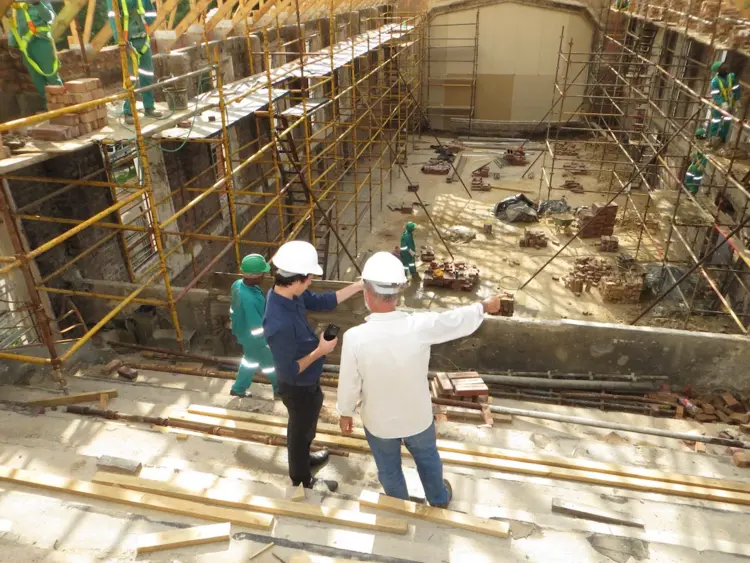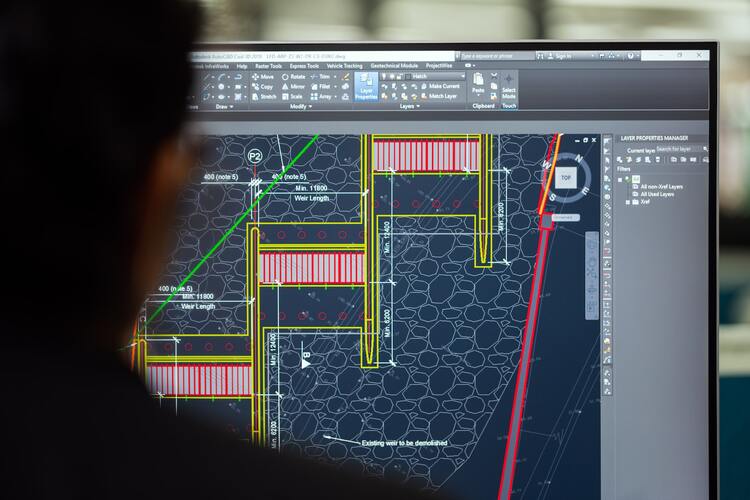7 SaaS Solutions to Transform and Modernize the Construction Industry
The construction industry is project-based, and while some of the largest companies always have work, this is not a rule in this field. When they get a project, contractors hire crews, rent equipment, and outsource various services.
In other words, the construction industry has existed on a SaaS model long before SaaS platforms were ever a thing. This makes integrating SaaS solutions into the construction industry simple and natural. Here are the top seven examples to further illustrate this point.

1. Digitizing construction blueprints and plans
By digitizing blueprints with the help of the right SaaS platform, you can easily save costs, increase time efficiency and even increase the accuracy and consistency behind your project-management efforts.
Since all these SaaS platforms are in the cloud, it’s a lot easier to establish a collaborative workplace. Anyone can access and check the blueprints and plans, meaning field teams no longer need to wait for confirmation from headquarters. Needless to say, this also makes the administrative aspect of project management a lot simpler.
The biggest challenge regarding these blueprints and plans would be version control. Fortunately, these cloud-based SaaS platforms always have a version control feature, and every change leaves a digital footprint. This means previous versions are retrievable, and it’s easy to trace an error back to the source.
The biggest challenge lies in actually choosing a SaaS platform to work through. Some of the most popular choices are
- Procore
- PlanGrid
- Bluebeam
- BIM 360
With their use, you get a centralized repository for all project-relevant documents and an easy way to access them on demand.
2. Building information model (BIM) SaaS
With the help of BIM software, you can drastically improve your project coordination. After all, the updates happen in real-time, and since the platform can be accessed remotely, it’s quite easy to resolve any dispute. You just check it to see who’s right.
If any change is involved, it can be immediately updated to the plan so there’s no confusion.
The most important aspect of BIM is its ability to run simulations. If you’re interested in how a certain decision would play out, you don’t have to make complex mathematical equations and risk making a mistake somewhere. You get an instant estimate, meaning you get all the necessary information before choosing.
In a way, you can use BIM similarly, in which businesses in other industries leverage BI. You get more information, which allows you to skip trial and error. This is even more important in this industry since errors are incredibly expensive to fix and may even put lives in danger. Both modern BI and BIM are AI-powered, so their computing capacities are quite formidable.
Most importantly, since there are many aspects to running a construction project, you can also integrate your BIM with other tools.
3. Tailoring work management platform for construction projects
A construction project is still a project. There are resources to manage, tasks to delegate, and schedules to organize. This can become much easier with the right work management platform. Now, while some platforms may be a bit better suited for construction projects, the truth is that you can customize most of the tools to serve the purpose.
First, you want to customize task templates to align with construction-specific activities. Ideally, you would take a platform that permits color-coding so that your staff can immediately focus on tasks relevant to their teams and ignore everything else. You want to categorize documents based on project phases to make them easier to track and oversee.
The collaboration features of these platforms are also a huge hit. You get to decide which staff members receive notifications on which tasks. This allows for streamlining various processes without flooding people with information that isn’t relevant to their project activity. You can also allow the client to see some of your processes without giving them access to everything.
The most important part of it all is the mobile access. Remember, everyone has a phone, which means that your construction supervisor will be available 24/7 and have access to all the plans and documentation they need.
4. Construction industry e-commerce
The highest costs in the construction industry come from your contracts with strategic vendors. This is why construction industry e-commerce platforms are such a game-changer.
Through these SaaS B2B solutions, you can easily make the procurement of materials and equipment much easier and more streamlined.
Remember that the cost is not everything, and the efficiency of your supplier makes all the difference. Just think about it, if you get material at a discount price, but you have to endure two weeks of downtime because of the delay in delivery, have you saved anything? In most fields, probably not, but in the construction industry, definitely not. Time is money, but a day of delay in construction is sometimes disproportionally expensive.
Another great thing about this is your ability to integrate this e-commerce platform with your ERP effectively. This way, you’re creating a strong foundation for your entire resource management system. Since you’re tracking your inventory in real-time, you’re ensuring you never face downtime because of a material shortage.
Not to mention that you can save money directly and capitalize on better deals.
5. Streamlining financial and project tasks
The construction industry is so complex from a financial standpoint. After all, there are so many supplies delivered, so many permits, penalties, and fines to be paid, not to mention a complex project payroll. This is project-based, even if you have some staff that’s permanently on the retainer.
You also need to keep in mind that, sometimes, you’re not owning the equipment but renting it daily, which further complicates your bookkeeping.
Generally speaking, creating estimates on the construction project is a nightmare. After all, you have no idea how much of your material will turn out to be faulty or get damaged in the project. You also have no idea how many days of delay you’ll have. Each of these days has a different cost; since you may not have to pay the construction crew on that day, you’re still paying a full day’s rent for your scaffold.
Overall, a great SaaS platform can do wonders when creating estimates. This is especially the case if you want/need a three-point estimate where you’re interested in the most:
- Optimistic
- Pessimistic
- Likely scenario
A good accounting platform can (with enough data) make a pretty accurate estimate that you can make your budget on.
Also, you want some help with invoicing.
6. Daily reporting and field management
To run a successful construction project, you can’t afford to wait for the result. You can’t wait for the last day to see if your team has missed the deadline. By then, it’s too late, and your company is already in for penalties and reputational damage.
Instead, you need a system for daily reporting and field management. This way, you can adjust, get your team back on track, or, at the very least, brace for the impact.
On a SaaS platform, you can create a daily work log, allowing you to make a simple digital entry. This way, the management can review what was done in the day.
You should always believe your field teams, but you also need to verify. You want receipts, logs, and photos from the site. All of this can be easily shared via the right SaaS platform.
Standardized templates will make record-keeping and subsequent analysis a lot simpler. Also, you may need all of this for the sake of compliance.
7. VR tour
Visualization was always a problem in architecture and construction. In the past, the best architects and project managers were the ones who could have the project in their heads long before they finished it.
Still, even they made mistakes since constructions are so complex that keeping every tiniest detail in your mind might be beyond the capacity of a human brain. Fortunately, with the help of a 3D virtual tour, you can see things instead of visualizing them.
Some may argue that this is not an improvement over accurate 3D models. If anything, 3D models can be done in more detail with less computing power, and you don’t need a VR headset, which most people don’t have and no one carries around.
Still, these two concepts are not mutually exclusive. You can use both VR and examine 3D models. If anything, by increasing immersion, VR models can help you pay more attention to the details in 3D models.
SaaS is transforming every field it touches, and the construction industry is not an exception
Ultimately, SaaS is amazing for project-based work models, which is what the construction industry is all about. It can help you run a tighter ship, provide a flexible platform, and tailor SaaS to your needs.






